How to use NORMDIST function in Excel
When working with data tables, Excel statistics, knowing and using Excel functions will help you complete your work. And in today's article, Network Administrator will introduce you to NORMDIST function in excel and how to use the function.
The NORMDIST function returns a normal distribution in Excel with a standard deviation and a defined mean. The function will be applied in the statistics table, examining the hypothesis. The following article uses NORMDIST function for Excel 2003 version to Excel 2013.
Use NORMDIST function in Excel
We have a syntax to use NORMDIST function (x, mean, standard_dev, cumalative).
In it :
- x: is the value to be distributed. Required parameters
- mean: The arithmetic average value of distribution. Required parameters.
- standard_dev: Standard deviation of distribution. Required parameters.
- cumalative: The logical value determines the function form. Required parameters.
- cumalative = true: Returns the result of the cumulative distribution function
- cumalative = false: Returns the result of the probability density function.
Note:
- If the average or standard deviation is not in the numerical form => the function returns the #VALUE! Error.
- If average = 0 and standard deviation = 1, cumulative = True => the function returns NORMSDIST normal distribution.
- If the standard deviation is less than 0 => the function returns the value #NUM !.
- When the cumulative value = TRUE => the distribution applies from negative negative to x value.
We have an example. The distribution of value 92 according to the table below.
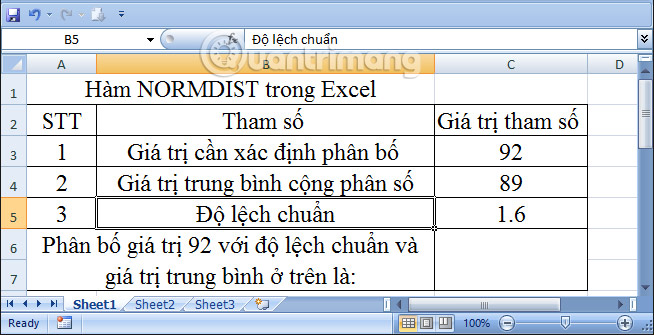
Case 1: Cumulative value TRUE (Cumalative = true)
Step 1:
In the cell to calculate, we enter the formula: = NORMDIST (C3, C4, C5, TRUE) .
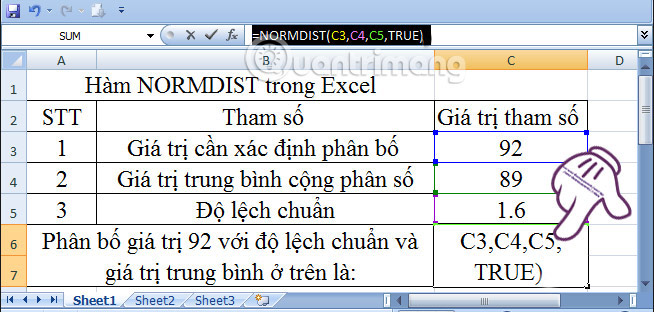
Step 2:
After entering the formula, press Enter and get the result as shown below.
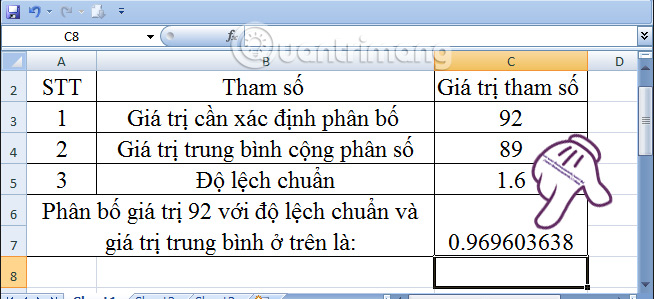
Case 2: Cumulative value = FALSE (Cumalative = false)
Step 1:
We enter the formula as follows: = NORMDIST (C3, C4, C5, FALSE) .
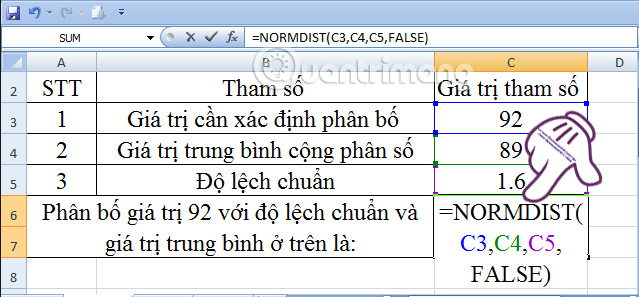
Step 2:
You also press Enter and get the result as shown below:
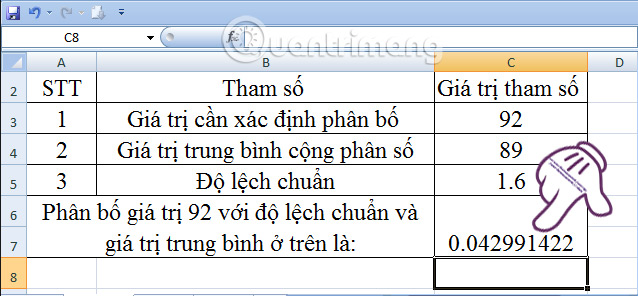
Case 3: If replacing the standard deviation = 1 and the mean = 0, accumulate = True> NORMDIST (92) = NORMSDIST (92)
NORMDIST function value (92
You read the formula: = NORMDIST (C3, C4, C5, TRUE) . And the result will look like below.
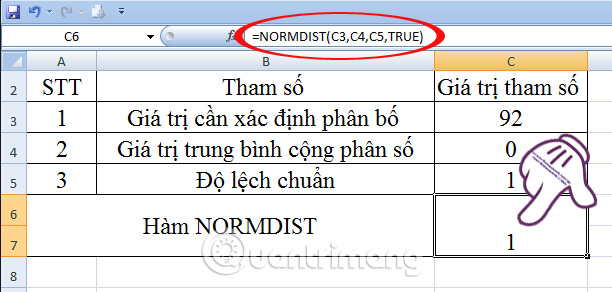
NORMSDIST function value (92):
We enter the formula: = NORMSDIST (C3) and the result is as below.
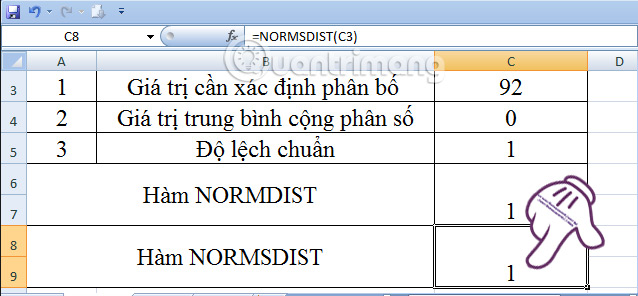
Thus, if the standard deviation = 1 average value = 0 and cumulative = true => NORMSDIST function is equal to NORMDIST function value.
The above is a tutorial on using NORMDIST function in Excel to calculate normal distribution with standard deviation and special case between NORMSDIST function and NORMDIST function.
Refer to the following articles:
- Summary of expensive shortcuts in Microsoft Excel
- 10 ways to recover corrupted Excel files
- How to reopen Word, Excel or PowerPoint files when closed but not saved yet?
I wish you all success!
You should read it
- Summary of trigonometric functions in Excel
- Look up data in Excel tables: Replace VLOOKUP with INDEX and MATCH
- How to create and delete tables in Excel
- How to repeat titles in Excel 2007, 2010 and 2013 when printing
- Instructions to delete 0, hide 0 in Excel
- Instructions on how to create diagonal lines in Excel box
- Instructions for adding alternate blank lines on Microsoft Excel
- Instructions for using Index function in Excel
May be interested
- How to use MID functions to get strings in Excel
 mid function in excel is a function that takes the middle character string corresponding to the value that the user requires to perform.
mid function in excel is a function that takes the middle character string corresponding to the value that the user requires to perform. - How to use Excel's VALUE function
 excel's value function will convert a string to a digital form, which can be combined with other functions such as left function, right function, mid function.
excel's value function will convert a string to a digital form, which can be combined with other functions such as left function, right function, mid function. - How to use the WRAPROWS function in Excel
 having trouble with handling large data sets in excel? then learn how to use the wraprows function to split them into more manageable rows.
having trouble with handling large data sets in excel? then learn how to use the wraprows function to split them into more manageable rows. - How to use the IFS function in Excel 2016
 the ifs function in excel is a logical function introduced in excel 2016. this function is a function that replaces the nested if function and is much easier to use. the ifs function checks one or more conditions and returns a value that meets the first true condition.
the ifs function in excel is a logical function introduced in excel 2016. this function is a function that replaces the nested if function and is much easier to use. the ifs function checks one or more conditions and returns a value that meets the first true condition. - How to use the NPER function in Excel to plan loans and savings
 do you want to effectively manage and control your personal finances? then we invite you to learn how to use excel's nper function.
do you want to effectively manage and control your personal finances? then we invite you to learn how to use excel's nper function. - How to use the function to delete spaces in Excel
 deleting white space with functions in excel makes it easier for users to handle content, instead of traditional editing.
deleting white space with functions in excel makes it easier for users to handle content, instead of traditional editing. - How to fix the SUM function doesn't add up in Excel
 in the process of summing with sum in excel, you will encounter some errors such as not jumping the number, not adding the sum. so how to handle this problem?
in the process of summing with sum in excel, you will encounter some errors such as not jumping the number, not adding the sum. so how to handle this problem? - How to use the SUBTOTAL function in Excel
 the subtotal function in excel is used in many different cases, helping you to sum subtotals in a list or database, unlike the sum function in excel such as counting cells, calculating average, finding the largest / smallest value. or sum the filtered list values in excel
the subtotal function in excel is used in many different cases, helping you to sum subtotals in a list or database, unlike the sum function in excel such as counting cells, calculating average, finding the largest / smallest value. or sum the filtered list values in excel - Save time with these text formatting functions in Microsoft Excel
 microsoft excel is a main application for anyone who has to work with numbers, from students to accountants. but its usefulness extends beyond a large database, it can do a lot of great things with text. the functions listed below will help you analyze, edit, convert, change text and save many hours of boring and repetitive tasks.
microsoft excel is a main application for anyone who has to work with numbers, from students to accountants. but its usefulness extends beyond a large database, it can do a lot of great things with text. the functions listed below will help you analyze, edit, convert, change text and save many hours of boring and repetitive tasks. - SUMPRODUCT function in Excel: Calculates the sum of corresponding values
 the sumproduct function is an extremely useful function when you have to deal with a lot of data numbers in microsoft excel. here are the things you need to know about the sumproduct function in excel.
the sumproduct function is an extremely useful function when you have to deal with a lot of data numbers in microsoft excel. here are the things you need to know about the sumproduct function in excel.










 Instructions for using Index function in Excel
Instructions for using Index function in Excel How to use the DAVERAGE function in Excel
How to use the DAVERAGE function in Excel The procedure to open Microsoft Office 2013/2016 in Safe Mode
The procedure to open Microsoft Office 2013/2016 in Safe Mode Instructions on how to open Word files, Excel suspects infection
Instructions on how to open Word files, Excel suspects infection Instructions on how to use the Dmax function in Excel
Instructions on how to use the Dmax function in Excel